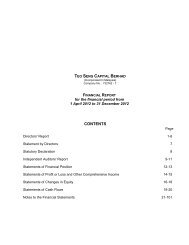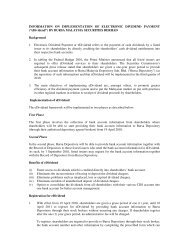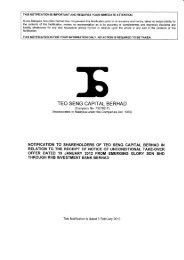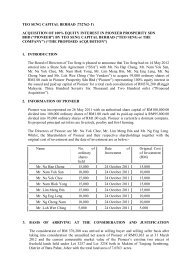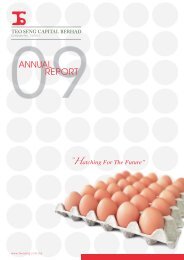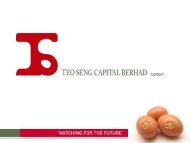Hatching For The Future - teo seng capital berhad
Hatching For The Future - teo seng capital berhad
Hatching For The Future - teo seng capital berhad
Create successful ePaper yourself
Turn your PDF publications into a flip-book with our unique Google optimized e-Paper software.
Teo Seng Capital Berhad<br />
Notes To <strong>The</strong> Financial Statements<br />
<strong>For</strong> <strong>The</strong> Financial Year Ended 31 March 2012<br />
4.<br />
ACCOUNTING POLICIES AND STANDARDS (cont’d)<br />
4.2<br />
Summary of Significant Accounting Policies (cont’d)<br />
(h) Financial instruments (cont’d)<br />
(i) Financial assets (cont’d)<br />
• Available-for-sale financial assets<br />
Available-for-sale financial assets are non-derivative financial assets that are designated in this<br />
category or are not classified in any of the other categories.<br />
After initial recognition, available-for-sale financial assets are remeasured to their fair values at the<br />
end of each reporting period. Gains and losses arising from changes in fair value are recognised in<br />
other comprehensive income and accumulated in the fair value reserve, with the exception of<br />
impairment losses. On derecognition, the cumulative gain or loss previously accumulated in the fair<br />
value reserve is reclassified from equity into profit or loss.<br />
Dividends on available-for-sale equity instruments are recognised in profit or loss when the Group’s<br />
right to receive payments is established.<br />
Investments in equity instruments whose fair value cannot be reliably measured are measured at<br />
cost less accumulated impairment losses, if any.<br />
(ii)<br />
Financial liabilities<br />
All financial liabilities are initially at fair value plus directly attributable transaction costs and subsequently<br />
measured at amortised cost using the effective interest method other than those categorised as fair value<br />
through profit or loss.<br />
Fair value through profit or loss category comprises financial liabilities that are either held for trading or<br />
are designated to eliminate or significantly reduce a measurement or recognition inconsistency that<br />
would otherwise arise. Derivatives are also classified as held for trading unless they are designated as<br />
hedges.<br />
(iii)<br />
Equity instruments<br />
Ordinary shares are classified as equity. Incremental costs directly attributable to the issue of new shares<br />
or options are shown in equity as a deduction, net of tax, from proceeds.<br />
Dividends on ordinary shares are recognised as liabilities when approved for appropriation.<br />
(iv)<br />
Financial guarantee contracts<br />
A financial guarantee contract is a contract that requires the issuer to make specified payments to<br />
reimburse the holder for a loss it incurs because a specific debtor fails to make payment when due.<br />
Financial guarantee contracts are recognised initially as liabilities at fair value, net of transaction costs.<br />
Subsequent to initial recognition, financial guarantee contracts are recognised as income in profit or loss<br />
over the period of the guarantee or, when there is no specific contractual period, recognised in profit or<br />
loss upon discharge of the guarantee. If the debtor fails to make payment relating to a financial guarantee<br />
contract when it is due and the Company, as the issuer, is required to reimburse the holder for the<br />
associated loss, the liability is measured at the higher of the best estimate of the expenditure required to<br />
settle the present obligation at the end of the reporting period and the amount initially recognised less<br />
cumulative amortisation.<br />
Annual Report 2012<br />
51



